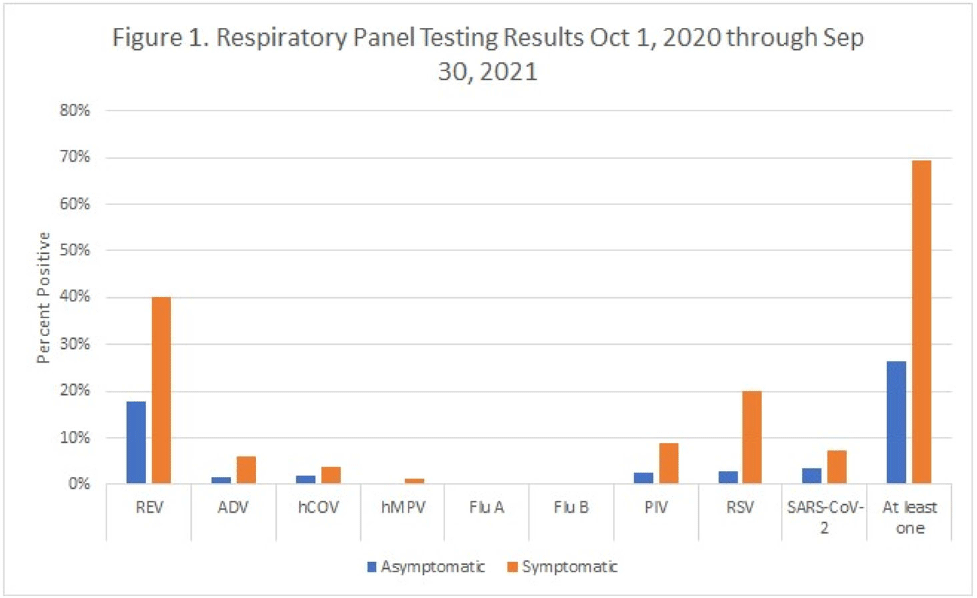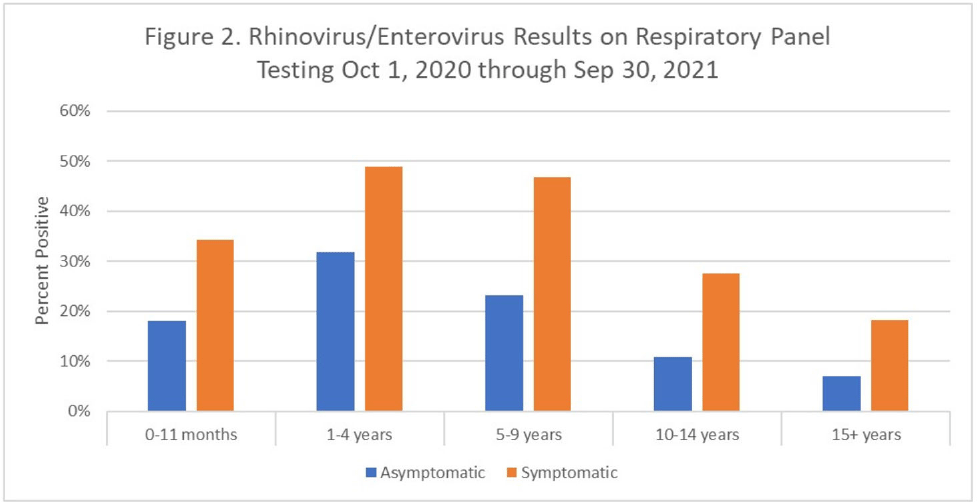No CrossRef data available.
Article contents
Respiratory Virus infections in symptomatic and asymptomatic children: Results of one year of hospital admission screening
Published online by Cambridge University Press: 16 May 2022
Abstract
Background: Respiratory viral infections are very common among children. Transmission-based precautions are frequently used with patients who test positive for a respiratory virus in pediatric hospitals to prevent transmission of infections, regardless of whether the patient has symptoms of a respiratory infection or not (asymptomatic). However, few data are available on the prevalence of respiratory viral infections in symptomatic and asymptomatic children who are admitted to a pediatric hospital. The study was conducted in 3 hospitals that combine for a 601-bed pediatric healthcare system in northern Texas. Methods: From July 7, 2020, to the present, all patients admitted to the hospital had a nasopharyngeal swab collected and tested with a multiplex PCR panel including SARS-CoV-2 and 8 other common respiratory viruses. Over a 1-year period from October 1, 2020, to September 30, 2021, the prevalences of infection with each of the 9 respiratory viruses were calculated and stratified by respiratory infection symptom status (determined by the ordering provider in an electronic order set) and age group. Results: During this 1-year period, 28,421 PCR panels were collected on patients admitted to the hospital. The median age was 5 years (IQR, 1–12 years), and 15,105 patients were male (53.2%). Overall, 12,792 panels were positive for at least 1 virus (45.0%). Among 26,688 panels on individuals with known symptom status, 26.3% of asymptomatic patients and 69.4% of symptomatic patients tested positive for at least 1 virus. The most common virus was rhinovirus or enterovirus (17.7% asymptomatic positive and 40.2% symptomatic positive) (Fig. 1). Asymptomatic rhinovirus or enterovirus prevalence varied by age group and was greatest in children aged 1–4 years (31.7%) and those aged 5–9 years (23.1%). It was lowest in adolescents aged 15–21 years (7.1%) (Fig. 2). Over time, the prevalence of asymptomatic infections fluctuated with local outbreaks. For SARS-CoV-2, in the resolution phase of an outbreak the prevalence of asymptomatic infections tended to overlap or surpass symptomatic infections. Conclusions: Asymptomatic respiratory viral infections, and in particular rhinovirus or enterovirus infections, were common among pediatric patients admitted to the hospital during the COVID-19 pandemic and were most common among children aged 1–9 years. However, symptomatic patients were still more likely to test positive for a respiratory virus compared to asymptomatic patients. Prolonged shedding of SARS-CoV-2 may explain why asymptomatic prevalence surpasses symptomatic prevalence in the resolution phase after outbreaks.
Funding: None
Disclosures: None


- Type
- Respiratory Viruses
- Information
- Antimicrobial Stewardship & Healthcare Epidemiology , Volume 2 , Issue S1: SHEA Spring 2022 Abstracts , July 2022 , pp. s61 - s62
- Creative Commons
- This is an Open Access article, distributed under the terms of the Creative Commons Attribution licence (http://creativecommons.org/licenses/by/4.0/), which permits unrestricted re-use, distribution, and reproduction in any medium, provided the original work is properly cited.
- Copyright
- © The Author(s), 2022. Published by Cambridge University Press on behalf of The Society for Healthcare Epidemiology of America




